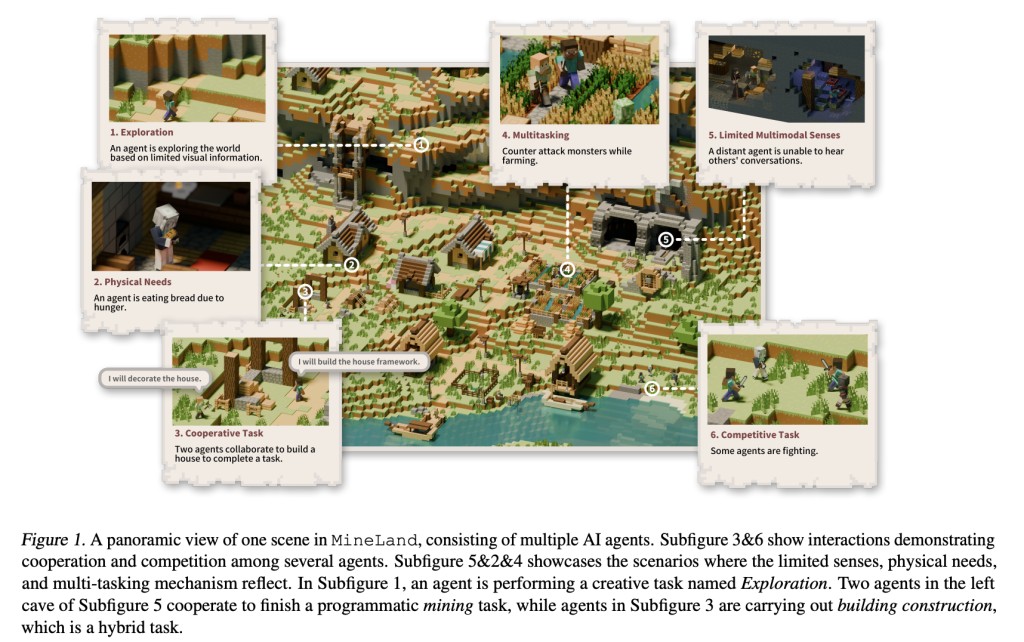Artificial intelligence (AI) has seen remarkable advancements in recent years, with researchers constantly pushing the boundaries of what machines can achieve. One area that has garnered significant attention is the development of multi-agent simulators, which aim to create virtual environments where AI agents can interact with each other and their surroundings. These simulations offer a unique opportunity to study collective behavior, social dynamics, and the emergence of complex systems. However, many existing multi-agent simulators operate under idealized conditions, assuming perfect information and unlimited capabilities for the agents involved. This disconnect from real-world constraints can limit the ecological validity and richness of the interactions observed in these simulated environments.
In an effort to bridge this gap, researchers have developed MineLand (shown in Figure 2), a Minecraft-based multi-agent simulator that introduces limited multimodal senses and physical needs as primary drivers of agent behavior and interaction. At its core, MineLand is designed to handle an unprecedented number of agents simultaneously, supporting up to 48 agents on a mainstream consumer desktop PC. This feat is achieved through an innovative architectural design that optimizes performance and resource utilization. Inspired by the assumption that agents possess only limited multimodal senses, MineLand’s agents operate under partially observable environments with restricted visual and auditory perception. This mirrors real-life social interactions, where visibility and audibility are affected by factors such as distance, terrain, and context. Furthermore, MineLand integrates realistic physical needs, such as hunger and the need for shelter, into its agents. These needs introduce a time-based aspect to the agents’ daily routines, necessitating collaboration and competition for resources, much like the complex interplay observed in human societies.
MineLand offers various task structures and difficulties, covering scenarios such as harvesting, tech tree progression, combat, survival, construction, and stage performances. Users can customize the number of players and choose between cooperative or competitive modes and the default free mode. This flexibility makes MineLand an excellent platform for benchmarking emergent multi-agent capabilities. To integrate agents into this simulator, the researchers have developed an AI agent framework called Alex (shown in Figure 3), inspired by Multitasking theory from the field of Cognition. Alex enables simultaneous simulation and execution of intricate coordination and scheduling across multiple tasks. This framework incorporates a multitasking component that allows agents to control their attention and working memory effectively, seamlessly switching between communication activities and goal-driven actions, much like humans in real-world scenarios.
The researchers have obtained intriguing findings through their experiments with MineLand and Alex. For instance, they observed that multimodal information enabled agents to perform more appropriate actions, while the multitasking mechanism allowed agents to process multiple tasks simultaneously by autonomously determining their priority. Additionally, limited senses forced agents to actively communicate to compensate for sensory deficiencies, and agents with physical needs exhibited longer survival times, mirroring real-life behavior. Notably, the researchers found that agents working together more effectively reduced the workload per agent, albeit at the cost of increased communication expenses. Furthermore, personality traits played a significant role in determining the behavior of agents in multi-agent societies, with agents exhibiting high openness tending to establish collaboration and engage in mutual communication. Â
MineLand represents a significant step forward in bridging the gap between virtual agents and real-world humans. By introducing limited multimodal senses and physical needs, this simulator offers a more realistic and nuanced environment for studying agent interactions and complex social dynamics. The findings obtained through MineLand and Alex not only advance our understanding of AI multi-agents but also hold immense potential for applications in fields such as human dynamics, social psychology, robotics, and game design. As researchers continue to explore the capabilities of this innovative platform, we can expect exciting new developments and progress in the field of embodied AI multi-agent systems.
Check out the Paper and Github. All credit for this research goes to the researchers of this project. Also, don’t forget to follow us on Twitter. Join our Telegram Channel, Discord Channel, and LinkedIn Group.
If you like our work, you will love our newsletter..
Don’t Forget to join our 39k+ ML SubReddit
The post This AI Paper from China Proposes MineLand: A Multi-Agent Minecraft Simulator that Bridges the Gap in Multi-Agent Simulations with Real-World Complexity appeared first on MarkTechPost.
Source: Read MoreÂ



